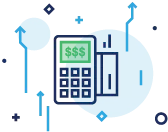
There are many factors to consider when deciding which point of service (POS) system will give your business the most value. The Shopify POS system is one of the most popular options among merchants.
The physical Shopify point-of-sale system is an extension of the brand’s eCommerce platform. It allows for easy integration with Shopify’s existing digital infrastructure and offers merchants impressive features and functionality.
However, the Shopify POS terminal has drawbacks. Before you completely invest in any POS system, it’s important to weigh the pros and cons and learn a bit more about its features. In this article, we’ll take a closer look at Shopify to see if it’s a viable choice for your business.
Basics of the Shopify POS Terminal
A POS system is a combination of the physical hardware (the computer and screen) and the digital software required to perform monetary transactions in person. It’s the infrastructure that processes payments and tracks sales data. Essentially, your POS terminal is where sales happen, and the key advantage of Shopify’s POS system is bridging the gap between in-person and eCommerce transactions.
Shopify unifies sales management processes and data for both online and physical transactions in one cohesive platform. This makes it much easier to guarantee consistency between in-person and online shopping experiences. Plus, it simplifies factors like inventory management, which can become complicated if you’re trying to juggle orders from multiple systems.
Features and Functionality of the Shopify POS Terminal
The basic functionality of the Shopify system is similar to many other payment terminals available on the market today.
However, determining if this system is right for your business is about understanding the value-adds and specifics of Shopify’s hardware and software. Here’s a look at the features and functions of the Shopify POS system that set it apart from the competition.

Sales and Payments
The most important function of any POS system is payment processing. The Shopify POS system can accept payments using all major methods with minimal setup. Customers can tap, chip, or swipe their cards, and transaction data is automatically saved in your account’s sales history.
More nuanced options like installments are offered to allow your customers to spread out payments over time, and you can accept and issue customized gift cards through your Shopify account.
Custom payment options can also be specially incorporated into your account settings. This way, you can process payment methods such as checks, store credit, or third-party terminals that Shopify isn’t normally designed to process. Keep in mind that if you frequently encounter alternative payment methods, Shopify’s POS system might not be the most efficient option for your business.
Shopify Payments facilitates transactions without the help of a third-party payment gateway. To get started, you only need to provide your employer identification number (EIN), banking information, average order price, and average shipping time.
One caveat with Shopify Payments is that it’s fairly restrictive in terms of which countries it’s available in. So, if you operate locations outside of the US, you should check if all of your locations can use Shopify.

Inventory
Managing the inventory of multiple locations while also operating an eCommerce store is no small feat. Coordinating stock levels requires extensive monitoring of your warehouse and your sales data.
Luckily, the Shopify POS system includes inventory management tools to ease the process. The platform’s “Stocky” tool lets you track and optimize inventory based on comprehensive sales data from all locations.
From your admin account, head to the inventory page. Here, you can view your counts, create transfers, enable tracking, or examine your history of adjustments for specific items. It’s also possible to isolate this information by location, making tracking the backend logistics of individual storefronts easier.
The platform also leverages your sales data to offer accurate inventory forecasting, allowing you to avoid dead stock and stock-outs.

Data Analytics
If you operate an eCommerce brand, you’re likely familiar with the concept of data analysis. Essentially, information regarding transactions, inventory, customer behavior, and financial metrics stored by your Shopify POS system can be used to generate brand performance insights.
Shopify’s POS system displays the average order value, number of sales, top products, return rates, and gross sales across each location. It also provides an online store conversion rate percentage, adding up the number of shopping sessions that result in a sale, along with a wide variety of other data analytics points specifically for eCommerce storefronts.
All told, Shopify is a good POS option in terms of data and analytics. Navigating the analytics page is straightforward and will keep you up-to-date on reporting regarding your operations.

System Integrations
You want your POS to function in tandem with the other digital tools you use to organize and oversee operations. System integrations are crucial for enhancing the functionality and efficiency of any POS terminal. They allow you to create a cohesive ecosystem that includes accounting software, customer relationship management (CRM) tools, and any other digital solutions you need to streamline operations.
Shopify POS integrates with Shopify’s other eCommerce solutions, meaning your payment portal will work seamlessly if you use Shopify. Additionally, sales data from Shopify POS can be automatically synced with software like QuickBooks or Xero, reducing the burden of manual entry.
Meanwhile, Shopify also allows for CRM integrations like Salesforce or HubSpot, allowing you to leverage customer data from Shopify POS.

Loyalty and Marketing
Shopify POS allows retailers to implement and manage loyalty programs directly through the system. These programs might offer repeat customers rewards, discounts, and special offers, encouraging them to continue shopping with the brand.
At the same time, Shopify’s POS solution can integrate with email and social media marketing tools, so you can use your sales data to create personalized campaigns. Then, you can mark the success of these efforts through the platform’s analytics tools.
While Shopify’s main purpose isn’t to handle all of your marketing functions, it can help add value to your outreach efforts.

Security
Digital security threats are always a matter of concern, especially for merchants and businesses. With this in mind, Shopify POS systems have a robust set of security measures in place to protect financial, business, and customer information. Shopify is PCI-compliant and adheres to the stringent standards set by the Payment Card Industry Data Security Standard. The platform also encrypts all data as an added layer of protection against theft.
That said, the platform isn’t foolproof. If login credentials are compromised, there’s a risk of unauthorized access to the POS system, leading to potential data breaches or fraudulent transactions. And Shopify’s reliance on internet connectivity potentially exposes the system to WiFi hacking. Be sure to follow proper online safety when using the platform.

Ease of Use
Shopify stands out from other alternatives because of its ease of use. The user interface is designed to flow intuitively, making it more natural to learn and navigate than other, more complex solutions.
However, the simplicity of Shopify POS can be a double-edged sword. The platform sacrifices a degree of technical customization options in favor of offering a more universally accessible interface. eCommerce retailers without the need for unique digital storefronts or functions likely won’t be bothered by the lack of customization features. However, if you need more than simple personalization options, Shopify might not suit your needs.
Setting Up Your Shopify POS Ecosystem
The setup process for Shopify POS is user-friendly and simple.
First, create a Shopify account (if you don’t already have one) using your basic business information. Once the account is created, configure your store settings, including payment methods, tax rates, and shipping options.
At this point, you’ll determine what type of hardware setup each location needs. Shopify POS options include card readers, receipt printers, barcode scanners, and cash drawers. Your hardware can integrate directly with your existing Shopify account, simplifying the setup process.
Next, you can either manually add your products and inventory listings or use the bulk option on the platform’s dashboard. Once this is done, train your employees on the new system before launch.
Finally, conduct regular updates to ensure that your POS system continues to run optimally.
The Shopify POS Terminal: What to Know
Shopify offers a wide range of useful features and functionalities, but you may still be wondering if this platform is right for you. So be sure to consider some things.
First and foremost, establish whether your existing hardware and software tools are compatible with Shopify. Otherwise, you’ll have to budget for new equipment such as Shopify’s Countertop Kit, POS Go, Tap & Chip Card Reader, or the mobile iPhone Tap to Pay tools.
Next, you may want to consider if the system offers enough scalability for your business needs. Small businesses can generally benefit from Shopify’s intuitive tools and ease of use. On the other hand, larger-scale operations might find the lack of customization options difficult to cope with.
Finally, your sales volume should be a key factor in your choice of POS system. In this regard, Shopify generally serves as a good option for high-volume merchants and companies. The Shopify POS should be able to handle peak sales periods without performance issues.
Fees, Plans, and Pricing
Shopify breaks its subscription plans into two broad categories. The first has everything needed for brick-and-mortar locations—but lacks the necessary features for eCommerce besides simply establishing an online store. The second category caters more explicitly to merchants who want to facilitate both in-person and online sales.
In-Person Sales
Starter Plan
$5/month
- It is ideal for occasional in-person sales like pop-ups and markets
- Includes one admin account, one POS Lite location, and a simple online store
- Credit Card Rates: 5% + $0.00 in person, 5% + $0.30 online
Retail Plan
$89/month or $79/month (Annual Subscription)
- Designed for regular in-store selling with additional features for managing staff, inventory, and customers
- Offers two admin accounts, unlimited POS logins, and a simple online store
- Credit Card Rates: 2.7% + $0.00 in person, 2.9% + $0.30 online
Selling Online and In-Person
Basic Plan
$39/month or $29/month (Annual Subscription) + $89/month for each POS Pro location
- Focused on in-store sales and enhancing online presence
- Features two admin accounts, unlimited POS logins, and a custom online store
- Credit Card Rates: 2.7% + $0.00 in person, 2.9% + $0.30 online
Shopify Plan
$105/month or $79/month (Annual Subscription) + $89/month for each POS Pro location
- Caters to smaller retailers, including professional reports and additional staff accounts for growing businesses
- Comes with five admin accounts, unlimited POS logins, and a custom online store
- Credit Card Rates: 2.5% + $0.00 in person, 2.6% + $0.30 online
Advanced Plan
$399/month or $299/month (Annual Subscription) + $89/month for each POS Pro location
- Ideal for medium and large businesses with high-volume sales, offering the best payment rates
- Offers 15 admin accounts, unlimited POS logins, and a custom online store
- Credit Card Rates: 2.4% + $0.00 in person, 2.4% + $0.30 online
Is Shopify POS Terminal Right for You?

Shopify POS offers a unified solution for businesses that integrates in-person and online sales. It also features useful functions like synchronized inventory management, multi-channel selling, data analytics, and various hardware options. It’s a solid, basic solution for businesses in need of an intuitive user interface that houses an all-in-one solution.
However, it’s not necessarily a viable option for all merchants and businesses out there. Namely, Shopify POS may not suit businesses that need advanced POS functionalities, those with complex inventory systems, or those operating in niche markets with specific requirements.
Businesses that either need these more advanced solutions now—or intend to invest in technology that can scale with them—might want to consider more personalized alternatives, such as a dedicated merchant provider.
At PaymentCloud, we specialize in matching merchant services, offering customizable payment structures, enhanced security features, and extensive integrations with enterprise-level platforms. Learn more about PaymentCloud’s customizable merchant services today to see if we can help you get your business off the ground.
Shopify POS Terminal FAQs
Does Shopify POS Cost Extra?
Hardware costs for items like iPads and scanners vary. However, POS Lite is included in all Shopify subscriptions and plans starting at $39 monthly. Alternatively, for an additional $89 monthly, you can upgrade to POS Pro to improve your inventory and staff management and obtain detailed reporting capabilities.
Can I Use Shopify POS on My Phone?
Yes, you can use your mobile device to facilitate transactions. Download the Shopify POS app and log in to your merchant account. Then, connect your mobile card reader to your phone to start accepting payments.
Does Shopify POS Work Without WiFi?
Shopify POS systems can operate without WiFi but only with limited functionality. In offline mode, you can still accept cash payments and track sales, but credit card transactions won’t process until you’re back online. Plus, functions like inventory management and reporting won’t sync until you’re back online.
Do I Need a Separate Card Reader With Shopify POS?
An additional card reader is necessary to accept debit and credit card payments using Shopify POS. Shopify provides two varieties of card readers: one that supports chip and swipe transactions (the Chip & Swipe Reader) and another that facilitates both tap and chip payments (the Tap & Chip Reader).







